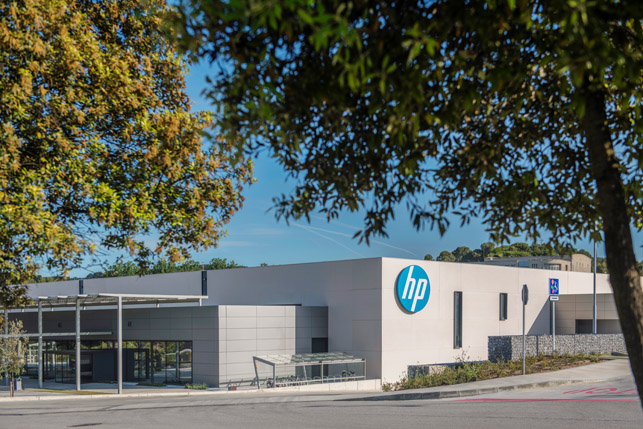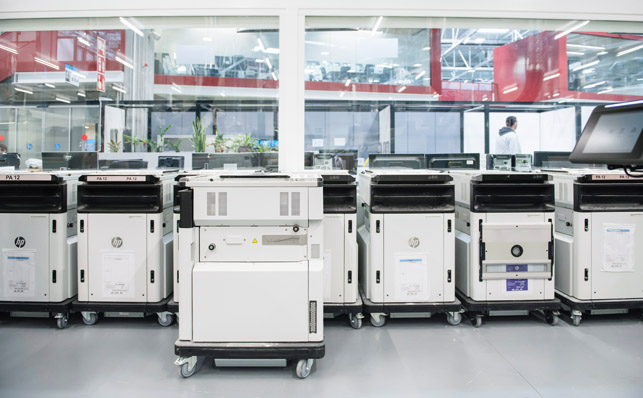
When HP announced its intention to enter the 3D printing arena back in 2014, it took almost two years for a machine to actually hit the market.
The end result was a significant dilution of the impact originally promised. Fast forward to today, however, and things are now moving rapidly in terms of how HP is developing its 3D printing and digital manufacturing offering.
The June 2019 opening in Barcelona of a brand-new global Centre of Excellence for this area of its business is ample evidence of the changes underway and the scale of HP’s ambitions.
This new facility is large, covering over 150,000 square feet – the size of three football pitches. HP executives claim it’s “possibly the largest of its kind in the world”, and it will house the company’s R&D efforts and ongoing development around its Multi Jet Fusion (MJF) technology.
HP used the grand opening as an opportunity to showcase exactly what the company is currently doing in this area and where it’s heading next.
The 300/500 series covers prototyping of functional parts, with the opportunity to make them in full colour if required.
The 4200 series, the mainstay of its offering until now, is suitable for prototyping and short production runs, and the newer 5200 series expands on this, with its focus squarely on using 3D printing for mass production.
HP – scaling up for volume production
The ability to offer 3D printing for volume production is interesting, with HP executives admitting that scaling up to this level is a complex proposition. It requires a fully developed quality management system (QMS) to provide the necessary assurances that customers look for when using parts produced in this way in the products that they sell.
This was the first time I’d heard HP execs talk about applying standard measures such as Overall Equipment Effectiveness (OEE) and Process Capability Index (Cpx) to 3D printing. More specifically, these measures can be used to assess product equipment utilisation and the accuracy/repeatability of parts produced, respectively.
According to HP executives, their ability to discuss these indices in relation to 3D printing is changing the conversations they have with customers, as the technology moves beyond the technology centres of manufacturing companies and onto the wider factory floor.
For the recently launched 5200 series printers, for example, HP has achieved an OEE of 80% and Cpk of 1.3. This very credible OEE rating, they claim, demonstrates that many of the failure-rate issues that often plague 3D printing can now be overcome, while the Cpk value indicates that 99.993% of parts remain within specific tolerances, in comparison to the tolerances achieved with injection moulding. It was interesting to hear the company state that getting to that Cpk figure was the result of software advances, and from exploiting machine learning, rather than improvements in hardware.

HP – partners and customers
HP views partnership as key to the way it continues to develop its MJF technology – a first for the company in this particular area. That’s perhaps because HP executives still view 3D printing technology as being in a ‘start-up’ phase, with outside assistance needed to offer fully integrated systems. Examples of partnerships here include those with Siemens, which is developing software systems to integrate 3D printing with established manufacturing workflows, and BASF, which is developing new materials.
In terms of the applications demonstrated there was relatively little here that we haven’t seen before, with one exception being the first examples of parts made with HP’s first flexible material, a TPU called UltraSint 3D TPU01, developed for HP by BASF.
And, given the move into volume production, the real stand-out use case to be showcased was that involving SmileDirectClub, a company that produces dental aligners. Its goal is to produce 20 million 3D-printed dental impressions over the next twelve months, using an army of 49 HP MJF printers. That means producing over 50,000 prints every day – a serious commitment indeed, in high-volume manufacturing terms.
It was also interesting to see that, as a very large manufacturing company in its own right, HP is benefiting from its own 3D printers. Where it makes sense to do so, economically and in design terms, it is using MJF to build some of the parts contained within its own 3D printers.
One example is a fan duct that has been redesigned using software from Siemens to optimise airflow. Computational Fluid Dynamica (CFD) simulation was used here, as was topology optimisation, to create a part that takes advantage of some of the design freedoms offered by 3D printing. The result is a part that replaces a six-piece injection-moulded part, offering a 34% cost reduction, a 22% improvement in airflow and a development time 75% faster than that associated with its predecessor.
It’s not just the 3D printer division at HP that’s using MJF, either. Ten manufacturing areas within HP are hard at work with the technology, creating new parts for textile printers, spare parts for out-of-production large-format printers, and fixtures for the company’s packaging lines.

Heavy metal
Having assembled a solid line-up of polymer printing solutions and applications, HP is now firmly focused on developing MJF for metals, with what it calls Metal Jet, scheduled to debut in 2020.
The company has a clear idea on which markets it will target with this technology – and it’s not aerospace, where a great deal of metal additive manufacturing activity is already focused, but instead sectors such as medical and industrial equipment, and automotive, where metal injection moulding (MIM) is widely used.
Metal Jet builds on five years of learning accrued in the development of MJF for polymers, because it utilises the same print heads as current machines. At the same time, it promises to be 50 times faster than laser-based metal machines and offer several advantages over MIM, including greater design freedom. Metal Jet machines from HP are expected to cost less than $399,000 at launch.
Partnership is equally important to Metal Jet as to other areas of HP’s push into 3D printing, as evidenced by the involvement of GKN’s powder metallurgy division, which brings its specialist expertise in MIM to the table. GKN has seen MIM use flatlining, so in strategic terms, metals 3D printing makes a great deal of sense to the company as a possible new growth area, with the potential not just as an alternative way to produce parts made with MIM today, but also larger, more complex parts.
People skills
One final theme that was mentioned several times is the skills that will be needed to take advantage these new technologies and approaches. As Ramon Pastor, HP’s global head of plastics solutions, 3D printing and digital manufacturing put it: “The more engineers and designers we educate in design for additive manufacturing, the quickly this business will scale.”
Here, the new Barcelona centre has an important role to play, as a venue where HP can engage with customers, assisting those with expertise in established manufacturing techniques to better understand how they can design for MJF, as well as ‘training the trainers’ who will take these skills development out into the field.
In summary, this latest step in HP’s commitment to 3D printing advances is impressive, especially the move into using MJF for volume manufacturing and the clear potential of Metal Jet. This new facility in Barcelona will clearly be a vital tool in delivering the company’s vision of where 3D printing and digital manufacturing should go over the next few years.






